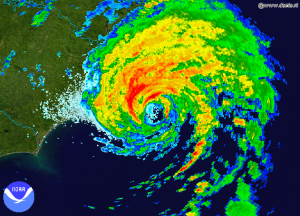The Saffir-Simpson scale for categorizing hurricanes by wind strength was developed in 1971 by Robert Simpson, a meteorologist, and Herbert Saffir, a civil engineer. Simpson and Saffir recognized the need for a better system through which to communicate the magnitude of impending storms to the public, and their solution was to sort hurricanes into 5 categories based on wind strength, and, thus, potential danger and damage. This practice became the accepted metric for qualifying hurricanes in 1974 and has been used ever since. If you’ve ever wondered about the criteria that earns a hurricane its categoric ranking, here is a brief overview of the 5 tiers of the Saffir-Simpson scale and what you can expect from storms in each category.
1. Category 1 Hurricanes: In a Category 1 hurricane, the wind strength measures between 74 and 95 mph, which demonstrates that every storm that has been qualified as a hurricane has the potential to cause damage and harm to residents and properties in the targeted area. The storm surge, which is a rising of the sea caused by atmospheric pressure changes and wind from a storm, is generally between 4 and 5 feet above normal in a Category 1 hurricane. Generally speaking, the most damage that you’ll see from a storm of this magnitude is the destruction of vegetation, like trees and shrubbery. Unanchored homes can also be negatively impacted by storms in this category.
2. Category 2 Hurricanes: In a Category 2 hurricane, the wind strength clocks in at between 96 and 110 mph, with a storm surge approximately 6-8 feet above normal sea-level. At this rank, you can expect to start seeing damage to more than just trees, as windows and doors are often affected in a Category 2 hurricane. Furthermore, it’s at this ranking that you have to start thinking about coastal routes and escape routes flooding; unlike in storms of a higher category, which tend to last longer, in Category 2 hurricanes, flooding begins a mere 2 – 4 hours before the arrival of the hurricane’s center.
 3. Category 3 Hurricanes: In a Category 3 hurricane, winds are now reaching speeds of between 111 and 130 mph, with a storm surge between 9 and 12 feet above normal sea-level. In Category 3 storms, you can expect any structure that is not tethered down to be severely damaged, if not blown away, and it is during storms of this magnitude that enormous trees can be uprooted, as well. Category 3s cause significant damage to smaller structures, both because of the wind and because of flying debris, and in these storms, you can anticipate flooding of coastal routes to occur 3 – 5 hours before the arrival of the hurricane’s center. To give you an idea of the strength of a Category 3 – Hurricane Katrina fell into this ranking, and even though it was only a Category 3 hurricane, it was one of the top 5 most fatal hurricanes to ever hit the USA.
3. Category 3 Hurricanes: In a Category 3 hurricane, winds are now reaching speeds of between 111 and 130 mph, with a storm surge between 9 and 12 feet above normal sea-level. In Category 3 storms, you can expect any structure that is not tethered down to be severely damaged, if not blown away, and it is during storms of this magnitude that enormous trees can be uprooted, as well. Category 3s cause significant damage to smaller structures, both because of the wind and because of flying debris, and in these storms, you can anticipate flooding of coastal routes to occur 3 – 5 hours before the arrival of the hurricane’s center. To give you an idea of the strength of a Category 3 – Hurricane Katrina fell into this ranking, and even though it was only a Category 3 hurricane, it was one of the top 5 most fatal hurricanes to ever hit the USA.
4. Category 4 Hurricanes: In a Category 4 Hurricane, devastation on a massive scale can be expected. During Category 4 storms, winds have picked up to a speed of between 131 and 155 mph, the storm surge has climbed 13 – 18 feet above normal sea-level, and low-lying escape routes begin flooding 3 – 5 hours before the center of the hurricane arrives. Storms of this magnitude can cause widespread fatalities; often, smaller buildings will experience complete roof structural failures, severe damage to doors and windows, and damage to the curtain walls (non-infrastructural walls). Trees, signs and mobile homes can be completely destroyed, and owing to the danger posed by such an intense storm, low-lying areas may need to be evacuated as far as 6 miles inland to minimize the number of injuries and fatalities incurred.
4. Category 5 Hurricanes: Category 5 Hurricanes are the most powerful, and thus dangerous, of all hurricanes. A storm earns the ranking of Category 5 when winds have reached speeds greater than 155 mph and the storm surge has risen to 18 feet above normal. In cases like these, most structures simply cannot withstand the impact of the storm winds and accompanying flying debris; often, complete roof failure is common. Category 5 hurricanes cause destruction on a massive scale; smaller structures can be blown away entirely, and buildings that are less than 15 feet above sea-level or within 500 yards of the shoreline are at an extreme risk of being destroyed. Evacuation of every resident within 5 – 10 miles of the shoreline is absolutely necessary during storms of this strength.
While these guidelines help us grasp the rough qualities of the 5 categories of hurricanes, it is most important to note that hurricane categorizations often change. Although our tools for predicting the weather are improving every day, it is always best to err on the side of caution when a hurricane is heading your way and prepare for the worst possible scenario – and, as always, please visit our website if you’re interested in investing in quality exteriors built to withstand the stress of extreme weather conditions.
If you need more info on the 5 Categories of Hurricanes, call Paradise Exteriors, LLC at 844-749-2121, or fill out our online request form.



